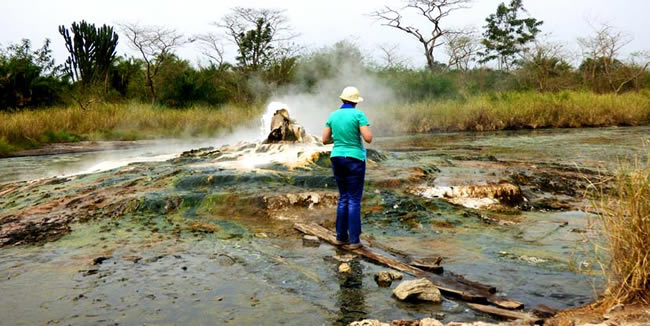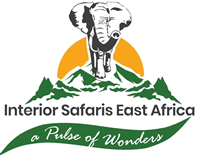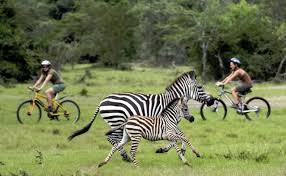
Situated in a remote corner of southwestern Uganda, Semliki National Park protects an eastern extension of the vast Ituri Forest and forms part of a forest continuum that stretches across the Democratic Republic of Congo to the Zaire River. Being a relatively stable forest “refugium” during the climatic upheavals of the Pleistocene, this is one of the richest areas for forest birds in Africa. A large number of predominantly Central African species reach the eastern limit of their distribution here and cannot be found anywhere else in East Africa. These include some of the continent’s most spectacular and sought-after birds such as; Congo Serpent Eagle, Long-tailed Hawk, Nkulengu Rail, Black-wattled Hornbill and Lyre-tailed Honey guide. Although it lies a bumpy three hours’ drive from Fort Portal, birders who take Uganda safaris, Semliki National Park will be richly rewarded with some of the very best forest birding in Uganda.
Bird Watching
Common species in this area are:- Spot-breasted Ibis, Hartlaubs’s Duck, Chestnut-flanked Goshawk, Red-thighed Sparrowhawk, Long-tailed Hawk, Forest Francolin, Nkulengu Rail, Western Bronze-napped Pigeon, Black-collared Lovebird, Yellow-throated Cuckoo, Red-chested Owlet, Bates’ Nightjar, Chocolate-backed, White-bellied and African Dwarf Kingfishers, White-crested, Black Dwarf, Red-billed Dwarf, Piping and Black-wattled Hornbills, Red-rumped Tinkerbird, Spotted, Lyre-tailed and Zenker’s Honeyguides, African Piculet, Gabon Woodpecker, Red-sided Broadbill, White-throated Blue Swallow, Green-tailed Bristlebill, Sassi’s Olive, Xavier’s, Swamp, Simple and Eastern Bearded Greenbuls, Yellow-throated Nicator, Capuchin Babbler, Northern Bearded Scrub Robin, Forest and Grey Ground Thrushes, Lemon-bellied Crombec, Brown-crowned Eremomela, Blue-headed Crested Flycatcher, Ituri Batis, Red-billed Helmet -Shrike, Red-eyed Puff-back, Black-winged Starling, Maxwell’s Black Weaver, Blue-billed, Crested and Red-bellied Malimbes, Pale-fronted and Chestnut-breasted Negro finches, Grant’s Bluebill.
Nocuturnal Bird Watching
The area around the geothermal hot springs at Sempaya is not only very scenic but also offers some great birding. The cliffs behind the ranger post are home to the crepuscular Freckled Nightjar and these can be seen gliding around the clearing with Black-shouldered Nightjars. In the lush rainforest around here listen for the bizarre dawn and dusk duetting of the elusive Nkulengu Rail. Other nocturnal callers include Buff-spotted Fluff tail and African Wood Owl. Around the cleaning and through other light gaps in the area, it is possible to glimpse African Goshawk, Red-thighed and Great Sparrows, Ayres Hawk-Eagle and Cassin’s Spine tail.
From the ranger post, head north (right) along the” Boundary Trail”. Crested Guinea fowl skulk in the undergrowth and the hollow hooting of the White-spotted Fluff tail is commonly heard near forest creek in this area. Turn left where the trail forks and continue to the ” Female” Hot Springs with boiling hot water squirts and bubbles out of the ground.
53 species of mammal have been recorded from the park, many of which are shy, rare and nocturnal. Conspicuous species include Grey-cheeked Mangabey, Vervet, Red-tailed and Mona, Gentle (Blue) Monkeys, Olive Baboon and Guereza Colobus, De Brazza’s Monkeys are rare and Chimpanzees may seldom be heard than seen. While nocturnal primates include Pottos and Galagos. You are also lucky if you glimpse Elephant, Bush pig, Water Chevrotain, Buffalo, Sitatunga, White-bellied Duiker or Dwarf Antelope, Beecroft’s Anomalure or Zenker’s Flying Mouse. You are far more likely to spot the lively and agile squirrels such as Fire-footed Rope or Red-legged Sun Squirrel. Little collard fruit Bat and Target Rat. 30 species of butterflies have been identified, including 46 species of forest Swallowtails and Charaxes (75% of Uganda’s total) and at least 235 species of moths have been classified as restricted.
There are also 305 species of trees recorded, of which 125 species are restricted to this park alone.
There is an observation tower and boardwalk to view the geothermal hot springs at Sempaya. Otherwise, there is not much in the way of visitor facilities in the park and trail maintenance has been neglected for a couples of years; a machete ( ” panga” ) can be useful. Bring all your supplies and camping equipment if you plan on spending time in the forest. There are three new but abandoned and unfurnished shelters at Sempaya ranger post that could accommodate a few uncomplicated travelers. Fresh drinking water can be obtained from the creek 0.6 km from Sempaya towards Bundibugyo and a swim in the Mungilo Waterfall here is also highly recommended. It is definitely advisable to boil or purify the water from the oxbow lakes and the Kirumia River prior to consumption. Recommended campsites in the forest are at the first oxbow lake and at the second Kirumia River crossing, and outside the forest at the Sempaya ranger post. Some local produce and drinks can be bought at Ntandi. Porters can be hired at the village of Kirumia at a rate of $ 2-3 per person.
Semliki National Park lies along the main fort Portal to Bundibugyo road, 52 km from Fort Portal. The road can become treacherous, particularly after heavy rains, requiring a 4 WD or a sturdy 2WD with sufficient clearance. The ranger post at Sempaya is well signposted but the park headquarters have been moved to the village of Ntandi, a further 4.4 km along the road to Bundibugyo. The usual National Park fees apply. From Sempaya it is 10.6 km to the village of Kirumia and start of the Kirumia River trail into the forest. It is possible to hitch a ride between Sempaya and Kirumia but bear in mind that most vehicles head towards Fort Portal in the mornings; traffic in the direction of Bundibugyo passes mainly in the late afternoon and evening.
3 Day Semliki National Park Safari
Day 1

Your Safari guide will pick up from your Hotel and depart by road for Semliki Wildlife Reserve; this scenic drive takes approximately 6-7 hours and will take you down the eastern side of Lake Albert. Semliki reserve is located in the basin of the Western Rift Valley. It is one of the most diverse habitats in Africa with wonderful examples of gallery rain forest; borassus palm forest, and short and high grass savannas Riparian forest. Chimps exist next to elephant, lion and buffalo and also the usual western Uganda species.
After dinner we will go on a night drive. This is the only place in Uganda where you can do a spot lit night drive. You never know what you may see. Often the big cats are sighted as well as the diminutive genet and serval cats. Unusual nocturnal dwellers also show themselves, such as the white tailed mongoose and slender mongoose, standard and pennant winged nightjars depending on the time of year. There are always surprises on the night drives.
Overnight at Semliki safari Lodge (FB)
Day 2
You will have tea in your tent, and then you will go down into the beautiful gallery rainforest to track wild chimpanzees. Chimps are tracked by researchers in Semliki at dawn and dusk, as they tend to disappear in the middle of the day. There are also a number of bird species which are found in this picturesque forest. Then you will return to the lodge for lunch and the chance to relax by the pool and enjoy the tranquility of the Lodge. In the late afternoon you will go for a game drive, stopping along the way to watch the African sun dip below the horizon.
Overnight at Semliki Safari Lodge (FB)
Day 3
We will depart to Kampala after breakfast, with our packed lunch arriving in the early evening.
The Safari price are;
The cost of all ground transportation and Fuel
Full time safari guide and his associated expenses
Park entrance fees
Accommodation and meals
Chimpanzee tracking
Game drive
It excludes;
Items of personal nature like Beverages. Laundry, Beers and tipping of staffs at the lodges.

